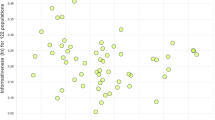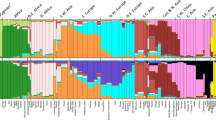Abstract
We studied the genetic relationships among East Asian populations based on allele frequency differences to clarify the relative similarities of East Asian populations with a specific focus on the relationships among the Koreans, the Japanese, and the Chinese populations known to be genetically similar. The goal is to find markers appropriate for differentiating among the specific populations. In this study, no prior data existed for Koreans and the markers were selected to differentiate Chinese and Japanese. We typed, using AB TaqMan assays, single-nucleotide polymorphisms (SNPs) at 43 highly selected mostly independent diallelic sites, on 386 individuals from eight East Asian populations (Han Chinese from San Francisco, Han Chinese from Taiwan, Hakka, Koreans, Japanese, Ami, Atayal, and Cambodians) and one Siberian population (Yakut). We inferred group membership of individuals using a model-based clustering method implemented by the STRUCTURE program and population clustering by using computer programs DISTANCE, NEIGHBOR, LSSEARCH, and DRAWTREE, respectively, calculating genetic distances among populations, calculating neighbor-joining and least-squares trees, and drawing the calculated trees. On average 52% of individuals in the three Chinese groups were assigned into one cluster, and, respectively, 78 and 69% of Koreans and Japanese into a different cluster. Koreans differentiated from the Chinese groups and clustered with the Japanese in the principal component analysis (PCA) and in the best least-squares tree. The majority of Koreans were difficult to distinguish from the Japanese. This study shows that a relatively few highly selected markers can, within limits, differentiate between closely related populations.





Similar content being viewed by others
References
Cavalli-Sforza LL, Edwards AWF (1967) Phylogenetic analysis: models and estimation procedures. Evolution 21:550–570
Cavalli-Sforza LL, Menozzi P, Piazza A (1994) The history and geography of human genes. Princeton University Press, Princeton
Chu JY, Huang W, Kuang SQ, Wang JM, Xu JJ, Chu ZT, Yang ZQ, Lin KQ, Li P, Wu M, Geng ZC, Tan CC, Du RF, Jin L (1998) Genetic relationship of populations in China. Proc Natl Acad Sci USA 95:11763–11768
Collins-Schramm HE, Chima B, Morii T, Wah K, Figueroa Y, Criswell LA, Hanson RL, Knowler WC, Silva G, Belmont JW, Seldin MF (2004) Mexican American ancestry-informative markers: examination of population structure and marker characteristics in European Americans, Mexican Americans, Amerindians and Asians. Hum Genet 114:263–271
Devlin B, Risch NA (1995) A comparison of linkage disequilibrium measures for fine-scale mapping. Genomics 29:311–322
Falush D, Stephens M, Pritchard JK (2003) Inference of population structure: extensions to linked loci and correlated allele frequencies. Genetics 164:1567–1587
Felsenstein J (1989) PHYLIP—phylogeny inference package, Version 3.2. Cladistics 5:164–166
Felsenstein J (1993) PHYLIP—phylogeny inference package, version 3.5p. (Distributed by the author, who is at the Department of Genetics, University of Washington, Seattle)
Frudakis T, Venkateswarlu K, Thomas MJ, Gaskin Z, Ginjupalli S, Gunturi S, Ponnuswamy V, Natarajan S, Nachimuthu PK (2003) Classifier for the SNP-based inference of ancestry. J Forensic Sci 48:771–782
Fullerton SM, Buchanan AV, Sonpar VA, Taylor SL, Smith JD, Carlson CS, Salomaa V, Stengard JH, Boerwinkle E, Clark AG, Nickerson DA, Weiss KM (2004) The effects of scale: variation in the APOA1/C3/A4/A5 gene cluster. Hum Genet 115:36–56
HGM6 (Human Gene Mapping 6, Oslo Conference, 1981) 6th International Workshop on Human Gene Mapping, Cytogenetics and Cell Genetics, vol 32, 1982
Jin HJ, Kwak KD, Hammer MF, Nakahori Y, Shinka T, Lee JW, Jin F, Jia X, Tyler-Smith C, Kim W (2003) Y-chromosomal DNA haplogroups and their implications for the dual origins of the Koreans. Hum Genet 114:27–35
Karafet T, Xu L, Du R, Wang W, Feng S, Wells RS, Redd AJ, Zegura SL, Hammer MF (2001) Paternal population history of East Asia: sources, patterns, and microevolutionary processes. Am J Hum Genet 69:615–628
Kidd KK, Cavalli-Sforza LL (1974) The role of genetic drift in the differentiation of Icelandic and Norwegian cattle. Evolution 28:381–395
Kidd KK, Sgaramella-Zonta LA (1971) Phylogenetic analysis: concepts and methods. Am J Hum Genet 23:235–252
Kidd JR, Pakstis AJ, Zhao H, Lu RB, Okonofua FE, Odunsi A, Grigorenko E, Tamir BB, Friedlaender J, Schulz LO, Parnas J, Kidd KK (2000) Haplotypes and linkage disequilibrium at the phenylalanine hydroxylase locus, PAH, in a global representation of populations. Am J Hum Genet 66:1882–1899
Kidd KK, Pakstis AJ, Speed WC, Kidd JR (2004) Understanding human DNA sequence variation. J Hered 95:406–420
Kim W, Shin DJ, Harihara S, Kim YJ (2000) Y chromosomal DNA variation in east Asian populations and its potential for inferring the peopling of Korea. J Hum Genet 45:76–83
Kivisild T, Tolk HV, Parik J, Wang Y, Papiha SS, Bandelt HJ, Villems R (2002) The emerging limbs and twigs of the East Asian mtDNA tree. Mol Biol Evol 19:1737–1751
Osier MV, Cheung KH, Kidd JR, Pakstis AJ, Miller PL, Kidd KK (2002) ALFRED: an allele frequency database for anthropology. Am J Phys Anthro 119:77–83
Parker HG, Kim LV, Sutter NB, Carlson S, Lorentzen TD, Malek TB, Johnson GS, DeFrance HB, Ostrander EA, Kruglyak L (2004) Genetic structure of the purebred dog. Science 304:1160–1164
Pritchard JK, Stephens M, Donnelly P (2000) Inference of population structure using multilocus genotype data. Genetics 155:945–959
Rolf B, Horst B, Eigel A, Sagansermsri T, Brinkmann B, Horst J (1998) Microsatellite profiles reveal an unexpected genetic relationship between Asian populations. Hum Genet 102:647–652
Rosenberg NA, Pritchard JK, Weber JL, Cann HM, Kidd KK, Zhivotovsky LA, Feldman MW (2002) Genetic structure of human populations. Science 298:2381–2385
Rosenberg NA, Li LM, Ward R, Pritchard JK (2003) Informativeness of genetic markers for inference of ancestry. Am J Hum Genet 73:1402–1422
Su B, Xiao J, Underhill P, Deka R, Zhang W, Akey J, Huang W, Shen D, Lu D, Luo J, Chu J, Tan J, Shen P, Davis R, Cavalli-Sforza L, Chakraborty R, Xiong M, Du R, Oefner P, Chen Z, Jin L (1999) Y-Chromosome evidence for a northward migration of modern humans into Eastern Asia during the last Ice Age. Am J Hum Genet 65:1718–1724
Tajima A, Pan IH, Fucharoen G, Fucharoen S, Matsuo M, Tokunaga K, Juji T, Hayami M, Omoto K, Horai S (2002) Three major lineages of Asian Y chromosomes: implications for the peopling of east and southeast Asia. Hum Genet 110:80–88
Tishkoff SA, Kidd KK (2004) Implications of biogeography of human populations for ‘race’ and medicine. Nat Genet Suppl 36:21–27
Wright S (1969) Evolution and the genetics of populations. The theory of gene frequencies, vol 2. University of Chicago Press, Chicago, p 511
Yao YG, Kong QP, Bandelt HJ, Kivisild T, ZhangYP (2002) Phylogeographic differentiation of mitochondrial DNA in Han Chinese. Am J Hum Genet 70:635–651
Acknowledgements
We thank the participants who donated DNA samples used in this study. This research was supported by grants from the National Institute of Health (AA09379 and GM 57672) and the Post-doctoral Fellowship Program of the Korean Science and Engineering Foundation.
Author information
Authors and Affiliations
Corresponding author
Electronic Supplementary Material
Rights and permissions
About this article
Cite this article
Kim, JJ., Verdu, P., Pakstis, A.J. et al. Use of autosomal loci for clustering individuals and populations of East Asian origin. Hum Genet 117, 511–519 (2005). https://doi.org/10.1007/s00439-005-1334-8
Received:
Accepted:
Published:
Issue Date:
DOI: https://doi.org/10.1007/s00439-005-1334-8




